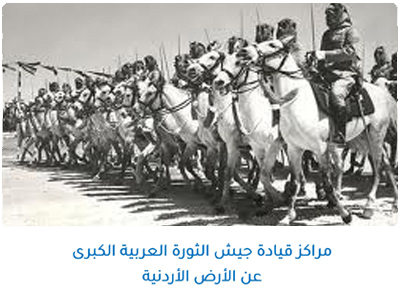Some areas on Jordanian
soil were established as command centers from which the Forces of the Great
Arab Revolt to start off, as follows: First Command Center
(Aqaba): The
front advanced military command on the Red Sea coast planned the occupation of
Aqaba. The military campaign, launched on May 17, 1917, was equipped to move
north to Madaen Saleh and then Bayer, and then it began its actions towards
Aqaba. Jordan was the field of operations of the Northern Great Arab Revolt
Army led by Prince Faisal bin Hussein, who moved from the front to Aqaba after
its occupation and took it as the center of his first Headquarters. Aqaba was a
turning point in the history of the Great Arab Revolt for the following
reasons: o Aqaba is the end of the dividing
line of the Sykes-Picot Agreement in the south. The occupation of Aqaba meant
that Arabs were to enter the sphere of influence of Britain and France, which
led allies to view this as an infringement of the Agreement and required a
review of conduct. o Aqaba has had historical value
since the time of the Nabataeans, Romans, Fatimids, Umayyads, and Abbasids, as
well as during the Mamluk and Ottoman era, and it is a center of administration
and rule throughout history. And during the Ottoman rule, it was an important
administrative center. o Aqaba is of strategic value as it
was a connection point between Sinai, Hijaz, and southern Jordan and an
important seaport, to which roads and land paths end. Start from Aqaba Road to
Wadi Araba, Wadi Alutem Road, and the eastern route that gives access to
Al-Medawara. o The Arabs took Aqaba as the first
command center because it facilitates communication with the Allied command in
Egypt and as a starting point to launch north towards Maan, Al-Tafila, Jorif
Al-Dararwiesh, and others. Aqaba remained a command center for
the Arab Revolution for up to three months, as Arab forces left at the end of
September 1917 to head to Camp Jordan in Al-Quwaira, about 75 km north of
Aqaba. Second Command Center
(Al-Quwaira):It is the second
Center for the leadership of the Arab forces and in which full plans have been
drawn up to march north and west to liberate Arab territory. The third command center
is Tlool Al-Samnat: Tlool Al-Samnat or Tlool Samneh is located west of Maan and was
taken by Arab forces as a command center for directing operations against the
Maan post and railway station, which the siege on them took a long time. The fourth command center
was Abu El-Lison: What
distinguished Abu El-Lison was that the planning to go north was done in it,
especially after the conference known as the "Abu El-Lison" military
conference, in which it was decided to expand the field of operations and
reorganize the Arab armies after increasing their numbers. The fifth command center
is Al-Tahonah and Al-Fiqei: These are two areas west of the
Al-Jardoun station, or Abi Al-Jardoun station. Prince Faisal had taken this
area as a command center, for his military operations towards the Al-Jardoun
station and towards the Aniza area to the north. From this command center, the
reconnaissance operations around Maan had been conducted. The sixth command center
is Ohaida: Awahid is the
ancient Arabic name of Monday. But Ohaida is the hole or the low ground, and
this applies to the area that lies to the west of Maan about (17) km and rises
about (1325) meters above sea level. Ohaida is almost in the heart of the west
of Maan. It is the closest and has an abundant water source and natural
pastures, very important to various animals, in addition to providing natural
protection by the mountains that surround it. Because of this, it was of
interest to the military forces in the region and was a military, administrative
and political command for them. The 7th Command Center is
Al-Azraq:It was the last
command center over Jordanian territory, where the final plan was drawn up to
advance north towards Damascus. The implementation was on September 29, 1918,
where Arab forces moved to Daraa and headed north to enter Damascus on October
1st, 1918, to begin the integrated Arab state phase.. After the integration of the Arab
forces, in Al-Azraq, was it chosen as a command center, because of its distance
from the presence of Turkish forces, and as a safe rear area- the shortest road
to Damascus across the desert line - and its convenience to all Arabs from all
over. Al-Azraq achieved strategic goals on the battlefield. The presence of
Arab forces in it was an advantage to close the interior area in front of the
movement of Turkish forces and provide protection to the southern front
extending from Al-Azraq to Daraa to Lake Tiberias. At the end of 1918, Hashemite Prince
Faisal bin Al Hussein established an independent government in Damascus. And he
requested independence at the Paris Peace Conference in 1919. But his request
was rejected by the colonial powers. In 1920, Prince Faisal took the throne in
Syria, and his brother Prince Abdullah was granted power in Iraq by the Iraqis
representatives. But the British government ignored the will of the Iraqis. And
the League of Nations issued the decision to mandate France to Syria, Lebanon,
and Britain over Jordan, Palestine, and Iraq. In October 1920, Prince Abdullah bin
Al Hussein led forces from Al-Hijaz to regain his brother's throne in the
Kingdom of Syria. But the French mandate was imposed on Syria, and prince
Abdullah was forced to delay his aspirations and focused his efforts on
establishing a government in Amman.
Arab Revolt Army Command Centers on Jordanian Soil

